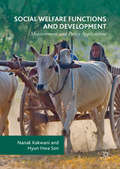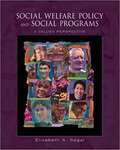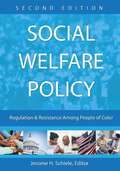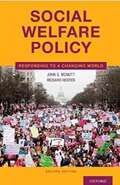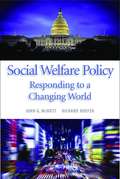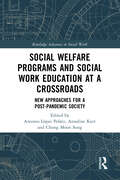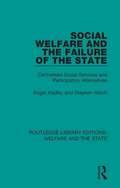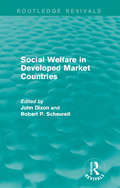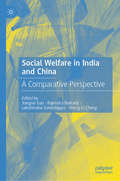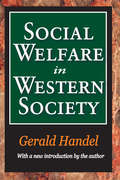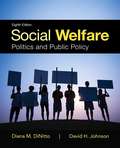- Table View
- List View
Social Welfare Functions and Development
by Nanak Kakwani Hyun Hwa SonNanak Kakwani and Hyun Hwa Son make use of social welfare functions to derive indicators of development relevant to specific social objectives, such as poverty- and inequality-reduction. Arguing that the measurement of development cannot be value-free, the authors assert that if indicators of development are to have policy relevance, they must be assessed on the basis of the social objectives in question. This study develops indicators that are sensitive to both the level and the distribution of individuals' capabilities. The idea of the social welfare function, defined in income space, is extended to the concept of the social well-being function, defined in capability space. Through empirical analysis from selected developing countries, with a particular focus on Brazil, the authors shape techniques appropriate to the analysis of development in different dimensions. The focus of this evidence-based policy analysis is to evaluate alternative policies affecting the capacities of people to enjoy a better life.
Social Welfare Policy and Social Programs: A Values Perspective
by Elizabeth A. SegalOffering a new values perspective, Elizabeth Segal's SOCIAL WELFARE POLICY AND SOCIAL PROGRAMS takes the student beyond identifying, describing, and analyzing social welfare policies. Segal demonstrates how the myriad values of diverse groups in America have influenced current policies, and helps students recognize that analysis takes place through the lens of these often opposing values. The dual themes of critical thinking and critical evaluation provide the framework of the book, and Segal's unique attention to international perspectives on values around social welfare policies and social programs heightens students' awareness of the global implications of social work around the world.
Social Welfare Policy and Social Programs: A Values Perspective
by Elizabeth A. SegalThis book is a comprehensive introductory social welfare policy text for both undergraduate and graduate students who are new to social work and human services. The book will help students to understand what drives social welfare policy and how it affects people's lives, and to gain insight into key issues of social concern. This book guides the reader through areas of social policy concern, including poverty, health care, child welfare, and aging, with a foundation of ideologies, theories, values, and beliefs to help explain our social welfare system. Each area is updated to reflect the latest policy developments. <p><p> This new edition includes detailed discussions of the key policies that have been enacted in recent years. The skills and resources necessary for teaching policy analysis are provided early in the book to better prepare students for analysis of the critical concerns that affect all aspects of social welfare policies and programs as they read through the rest of the book. Infused throughout the book are references to the Council on Social Work Education's Educational Policy and Accreditation Standards (EPAS).
Social Welfare Policy and Social Programs: A Values Perspective
by Elizabeth A. SegalOffering a new values perspective, Elizabeth Segal's SOCIAL WELFARE POLICY AND SOCIAL PROGRAMS takes the student beyond identifying, describing, and analyzing social welfare policies. Segal demonstrates how the myriad values of diverse groups in America have influenced current policies, and helps students recognize that analysis takes place through the lens of these often opposing values. The dual themes of critical thinking and critical evaluation provide the framework of the book, and Segal's unique attention to international perspectives on values around social welfare policies and social programs heightens students' awareness of the global implications of social work around the world.
Social Welfare Policy: Regulation and Resistance Among People of Color
by Dr Jerome H. SchieleApplying the social control paradigm to people of color, this text uses a racism-centered perspective of social welfare policy analysis to examine how such policies have regulated the lives of people of color and then employs a strengths-based approach to describe how they have refused to go along with the oppressive features of these policies. It illuminates the need for culturally competent social welfare policy practitioners, illustrating how racism continues to be at the center of many contemporary social problems such as issues of employment, public and bilingual education, housing and residential patterns, citizens' rights, and affirmative action—and of the social welfare policies used to address these issues.This book is an ideal core or supplementary text for Social Policy courses in departments of social work or human services. It is also a must-read for social welfare policy advocates and analysts and for anyone interested in how the themes of social welfare policy regulation and resistance are relevant to people of color.
Social Welfare Policy: Regulation and Resistance Among People of Color
by Jerome H SchieleFeaturing chapters written by leading scholars in the social work discipline, the second edition of Social Welfare Policy: Regulation and Resistance among People of Color examines how American social welfare policies, both historical and current, have sought to control the lives of marginalized populations. The chapters also explore how people of color have organized to critique and resist the racial control aspects of these policies. Each of the book's four parts are devoted to the major groups of color in the United States: Native American or First Nation peoples; Hispanic or Latino/Latina Americans; Asian Pacific Americans; and African Americans. Contributors highlight how oppressive or racially regulatory social welfare policies have affected education systems, child protective services, spiritual and religious practices, immigration laws, incarceration rates, and foster care and adoption services. Readers learn how specific groups have countered these policies through collective resistance, advocacy for alternative policies, civil and political participation, and more.
Social Welfare Policy: Regulation and Resistance Among People of Color
by Jerome H. SchieleApplying the social control paradigm to people of color, this text uses a racism-centered perspective of social welfare policy analysis to examine how such policies have regulated the lives of people of color and then employs a strengths-based approach to describe how they have refused to go along with the oppressive features of these policies. It illuminates the need for culturally competent social welfare policy practitioners, illustrating how racism continues to be at the center of many contemporary social problems such as issues of employment, public and bilingual education, housing and residential patterns, citizens' rights, and affirmative action―and of the social welfare policies used to address these issues.
Social Welfare Policy: Responding To A Changing World
by Richard Hoefer John G. McNuttSocial Welfare Policy: Responding to a Changing World is a topical, comprehensive introduction to social welfare policy. It uses a contemporary framework that explicitly addresses three forces that have redefined the social policy arena: the growth of the information economy, the rise of globalization, and our current environmental crisis. This framework is applied to the six traditional arenas of policy--child and family services, health and mental health, poverty and inequality, housing and community development, crime and violence, and aging, and explores how to find solutions to both long enduring and brand new problems. John McNutt and Richard Hoefer's introductory text represents a move forward in social welfare policy thinking that is built on the latest scholarship and teaches students that the time to create social policies for the future is in the present.
Social Welfare Policy: Responding To A Changing World
by Richard Hoefer John G. McnuttSocial Welfare Policy: Responding to a Changing World is unlike other books used in social welfare policy courses. John McNutt and Richard Hoefer explicitly address the emerging information economy, the rise of globalization, and the developing environmental crisis, and provide a tightly integrated framework for understanding these forces and their impact on policy and practice. This framework is applied to the six traditional arenas of policy--child and family services, health and mental health, poverty and inequality, housing and community development, crime and violence, and aging--exploring how to find new solutions to problems both long enduring and brand new. There is an urgency to this text that is clearly communicated to readers--it is time for practitioners, researchers, and policy-makers to make decisions for the future based on the realities of the present.
Social Welfare Programs and Social Work Education at a Crossroads: New Approaches for a Post-Pandemic Society (ISSN)
by Antonio López Peláez Annaline Keet Chung Moon SungThis book explores a key phenomenon that has been accelerated by the COVID-19 crisis, namely, the crossroads at which social welfare professionals find themselves. This is a crossroads where, on the one hand, there is an accelerated digitalization process and a reorganization of social programs, while on the other hand, we are confronted by the basic challenge of designing social policies and their methods of evaluation, that is, the generation of robust data that will allow better evaluation of social projects and programs.Rigorously analyzing the crossroads at which social welfare programs find themselves and the new demands for the education of professionals involved in social welfare programs, several key issues can be discerned;• the theoretical debate surrounding the changes brought about by the COVID-19 pandemic and the process of redefining globalization in which we are immersed.• the challenges to be met by welfare programs, and the good practices that are being implemented.• the key issue of how to generate more robust data in the field of social services and social protection.• how to increase the competencies of professionals through education in schools of social work.Providing 15 newly written chapters drawn from both the global north and the global south, it offers a set of recommendations to address the challenges of inequality and social inclusion in the coming years.It will be of interest to all academics, students and practitioners working in the fields of social work, social welfare and social development.
Social Welfare Services For Israel's Arab Population
by Aziz HaidarIn the mid-1980s, over 40 percent of Arab households fell below the poverty line. In this book, Dr. Haidar, a Palestinian living in Israel, presents the results of extensive fieldwork in Arab and Jewish localities on the social conditions and welfare service needs of Arab children, youth, and elderly in Israel.
Social Welfare and the Failure of the State: Centralised Social Services and Participatory Alternatives (Routledge Library Editions: Welfare and the State #6)
by Roger Hadley Stephen HatchOriginally published in 1981 Social Welfare and the Failure of the State looks at how the 1980s have ushered in an intensification on the debate of the role of the state in social welfare. The book highlights the trends towards centralisation in modern Britain and then provides a critical argument on to new ground. It highlights the trends towards centralisation in modern Britain and then provides a critical analysis of the growth of the social services in the 1960s and 1970s. But its target is the way these services were provided, not the amount of money spent on them. The authors argue that they have grown in the wrong direction.
Social Welfare in Africa (Routledge Revivals: Comparative Social Welfare)
by John DixonFirst published in 1987, this book analyses social welfare in the major countries of Africa, at that time. For each country it considers the ideological framework underlying the social welfare system and describes the historical development of both the system and the political and socio-economic context. Each chapter looks at the structure and administration of the systems in place and how these are financed. Contributions examine the nature of the different parts of the welfare system, surveying social security, personal social services, and the treatment of the following key target groups: the aged; those with disabilities and handicaps; children and youth; disadvantaged families; the unemployed; and the sick and injured. Each chapter concludes with an assessment of the effectiveness of the system considered. In this book, particular attention is paid to the role of foreign aid agencies and to missionaries, and to the special problems of poverty and famine in Africa.
Social Welfare in Asia (Routledge Revivals: Comparative Social Welfare)
by John Dixon Hyung Shik KimFirst published in 1985, this book analyses social welfare in the major countries of Asia, at that time. For each country it considers the ideological framework underlying the social welfare system and describes the historical development of both the system and the political and socio-economic context. Contributions examine the nature of the different parts of the welfare system, surveying social security, personal social services, and the treatment of the following key target groups: the aged; those with disabilities and handicaps; children and youth; disadvantaged families; the unemployed; and the sick and injured. Each chapter concludes with an assessment of the effectiveness of the system considered.
Social Welfare in Developed Market Countries (Routledge Revivals: Comparative Social Welfare)
by John Dixon Robert P. ScheurellFirst published in 1989, this book analyses social welfare in countries with highly developed economies, at that time. For each country it considers the ideological framework underlying the social welfare system and describes the historical development of both the system and the political and socio-economic context. Each chapter looks at the structure and administration of the systems in place and how these are financed. This is followed by a consideration of the nature of different parts of the welfare system, a survey of social security, personal social services and the treatment of the following key target groups: the aged; those with disabilities and handicaps; children and youth; disadvantaged families; the unemployed; and the sick and injured. Each chapter concludes with an assessment of the effectiveness of the system considered.
Social Welfare in East Asia and the Pacific
by Sharlene B. C. L. FurutoIn this singular collection, indigenous experts describe the social welfare systems of fifteen East Asian and Pacific Island nations and locales. Vastly understudied, these lands offer key insight into the successes and failures of Western and native approaches to social work, suggesting new directions for practice and research in both local and global contexts.Combining international experiences and professional knowledge, contributors illuminate the role of history and culture in shaping the social welfare systems of Cambodia, China, Hong Kong (SAR, China), Indonesia, Malaysia, the Micronesian region (including the Federated States of Micronesia, Guam [Unincorporated Territory, U.S.A.], Marshall Islands, Northern Mariana Islands [Commonwealth, U.S.A.], and Palau), Samoa and American Samoa (Unincorporated Territory, U.S.A.), South Korea, Taiwan, and Thailand. The contributors link the values and issues that concern populaces most to the development of social work practice, policy, and research. Sharlene B. C. L. Furuto then conducts a comparative analysis of the essays including their data and social service programs, highlighting the similarities and differences between the evolution of social welfare in these nations and locales. She contrasts their indigenous approaches, the responses of governments and NGOs to social issues, the availability of social work education, as well as API models, paradigms, and templates, and the overall status of the social work profession. Furuto also adds a chapter comparing the distinct social welfare systems of Samoa and American Samoa. The only volume to focus exclusively on social welfare in East Asia and the Pacific, this anthology holds immense value for practitioners and researchers eager for global perspectives.
Social Welfare in India and China: A Comparative Perspective
by Rajendra Baikady Jianguo Gao Lakshmana Govindappa Sheng-Li ChengFocusing on social work and social service delivery, this book examines the social policies and programmes designed to address different societal issues and concerns across India and China. It focuses on gaining understanding of design and delivery of social welfare policies related to special interest groups, highlighting important contemporary challenges such as child labour, child abuse, exploitation of women, problems related to disabled people, mental health issue, illiteracy and unemployment. Offering a comparative perspective, the book considers the impact of political administration in both countries to critically assess key issues related to social welfare in two different political, economic, social, and cultural contexts.
Social Welfare in Latin America (Routledge Revivals: Comparative Social Welfare)
by John Dixon Robert P. ScheurellFirst published in 1990, this book analyses social welfare in Latin America, at that time. For each country it considers the ideological framework underlying the social welfare system and describes the historical development of both the system and the political and socio-economic context. Each chapter looks at the structure and administration of the systems in place and how these are financed. This is followed by a consideration of the nature of different parts of the welfare system, a survey of social security, personal social services and the treatment of the following key target groups: the aged; those with disabilities and handicaps; children and youth; disadvantaged families; the unemployed; and the sick and injured. Each chapter concludes with an assessment of the effectiveness of the system considered.
Social Welfare in Socialist Countries (Routledge Revivals: Comparative Social Welfare)
by John Dixon David MacarovFirst published in 1992, this book analyses social welfare in eight socialist countries, at that time: Czechoslovakia, China, Cuba, Hungary, Poland, Yugoslavia, North Korea and the Soviet Union. For each country it considers the ideological framework underlying the social welfare system and describes the historical development of both the system and the political and socio-economic context. Each chapter looks at the structure and administration of the systems in place and how these are financed. This is followed by a consideration of the nature of different parts of the welfare system, a survey of social security, personal social services and the treatment of the following key target groups: the aged; those with disabilities and handicaps; children and youth; disadvantaged families; the unemployed; and the sick and injured. Each chapter concludes with an assessment of the effectiveness of the system considered.
Social Welfare in The Middle East (Routledge Revivals: Comparative Social Welfare)
by John DixonFirst published in 1987, this book analyses social welfare in the major countries of the Middle East, at that time. For each country it considers the ideological framework underlying the social welfare system and describes the historical development of both the system and the political and socio-economic context. Each chapter looks at the structure and administration of the systems in place and how the systems are financed. Contributions examine the nature of the different parts of the welfare system, surveying social security, personal social services, and the treatment of the following key target groups: the aged; those with disabilities and handicaps; children and youth; disadvantaged families; the unemployed; and the sick and injured. Each chapter concludes with an assessment of the effectiveness of the system considered.
Social Welfare in Transitional China (Sociology, Media and Journalism in China)
by Keqing HanAt a time of significant transformations in Chinese society, this book addresses the key issue of social welfare and the reform of the welfare system in 21st century China. Considering both the theory and policy making across a variety of welfare issues which directly impact on the country’s economic development, it examines the development of civil society, changes in social stratification and in social class structure. It notably considers the key questions of welfare in both urban and rural settings, for different population groups such as children, the elderly and the disabled, addressing topical issues of housing, education, public health, poverty and the restructuring of related welfare policy system to tackle China’s key issues. It also considers the impact of migrant workers in China and their social integration, including within the welfare system. Providing a unique insight into how economic globalization and financial crisis affects Chinese social welfare policies, this book is a key read for scholars worldwide interested in social transformation in Chinese society at a time of significant social and economic transition.
Social Welfare in Western Society
by Bernice NeugartenSocial welfare has a three-thousand-year history in Western society. Th is book off ers a sociological framework that provides conceptual order to the countless details of that history, while highlighting its essentials. Social welfare in all its forms is based on one central concept-help. But there are many versions of help and multiple debates about those versions. Th e outcomes of some debates have led to withholding help, and these outcomes are an inescapable part of this domain, in the past and in the present. Th e major versions, their development, and the debates are carefully examined in this volume.
Social Welfare: A History Of The American Response To Need
by June Axinn Mark SternSocial Welfare: A History of the American Response to Need enables students to place current issues of social concern in their historical contexts. It examines the comprehensive history of social welfare from the 18th century to the present, while exploring the ideas―as well as the economic and political forces―that have shaped policy development. Using numerous original documents to provide a clearer picture of historical periods, the authors show how social conditions, ideas about dependency and poverty, and institutions have shaped social policy and the efforts of voluntary organizations and individuals who work with at-risk populations. This book is part of the Connecting Core Competencies Series, which helps students understand and master CSWE’s core competencies with a variety of learning aids that highlight competency content and critical-thinking questions for the competencies.
Social Welfare: Politics And Public Policy
by Diana M. Dinitto David H. JohnsonAcknowledged as the most comprehensive, easy-to-read introduction to social welfare policy available, Social Welfare: Politics and Public Policy, 8/e, emphasizes the current political aspects of policy making and major social welfare programs, including public assistance, Social Security, disability, health insurance, child welfare, and much more. Social Welfare does more than describe the major social welfare policies and programs; it also tackles the conflict and controversies involved in the processes and outcomes of policy making. It contrasts rational and political approaches to policy making, policy analysis, policy implementation, and policy evaluation. The authors present conflicting perspectives, encouraging students to think critically, to debate, and to consider their own views on issues.
Social Welfare: Scottish Perspective (Routledge Revivals)
by Mono ChakrabartiThis title was first published in 2001. This volume, adopting a Scottish perspective, concentrates on welfare issues in the UK. The book acknowledges the fact that the Scottish legislative base has, historically, been different from the rest of the country, and explores the impact of these differences upon the nature of welfare institutions and service provision. The contributors also critically investigate the important changes being implemented in Scotland within the disaggregated local authority structure, exposing the resource implications for service providers. The book tackles policy issues ranging from poverty and social security to health care, education and criminal justice. An analysis of the relevant laws is incorporated into every chapter, together with an investigation of the crucial implications of social and welfare policies for family structure, class and ethnicity.
